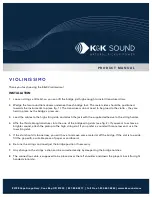
2
upon the coupling type or time constant of the external
charge amplifying device. This characteristic may be
fixed or adjustable, depending on the charge amplifier.
Please refer to the appropriate charge amplifier
specification sheet for information on low-frequency
characteristics.
Figure 1.
Assorted Mounting Configurations and Their
Effects on High Frequency
4.1 STUD MOUNT
This mounting technique requires smooth, flat contact
surfaces for proper operation and is recommended for
permanent and/or secure installations. Stud mounting is
also recommended when testing at high frequencies.
Note:
Do NOT attempt mounting on curved, rough, or
uneven surfaces, as the potential for misalignment and
limited contact surface may significantly reduce the
sensor’s upper operating frequency range.
Figure 2.
Mounting Surface Preparation
STEP 1:
First, prepare a smooth, flat mounting surface,
then drill and tap a mounting hole in the center of this
area as shown in Figure 2 and in accordance with the
Installation Drawing
for the specific sensor that is
being mounted
.
A
precision-machined
mounting
surface
with
a
minimum
finish
of
63
µ
in
(0.00016
mm)
is
recommended. (If it is not possible to properly prepare
the test structure mounting surface, consider adhesive
mounting as a possible alternative.) Inspect the area,
checking that there are no burrs or other foreign
particles interfering with the contact surface.
STEP 2:
Wipe clean the mounting surface and spread
on a light film of grease, oil, or similar coupling fluid
prior to installation.
Figure 3.
Mounting Surface Lubrication
Adding
a
coupling
fluid
improves
vibration
transmissibility by filling small voids in the mounting
surface and increasing the mounting stiffness. For semi-
permanent mounting, substitute epoxy or another type of
adhesive.
STEP 3:
Screw the mounting stud into the base of the
accelerometer
and
hand-tighten.
Then,
screw the
sensor/stud assembly into the prepared tapped hole and
tighten to the recommended mounting torque as
indicated on the
Installation Drawing
.
Note:
It is important to use a torque wrench during this
step.
Under-torquing the sensor may not adequately
couple the device; over-torquing may result in stud
failure.
4.2 ADHESIVE MOUNT
Adhesive mounting is often used for temporary
installation or when the test object surface cannot be
adequately prepared for stud mounting. Adhesives like
hot glue and wax work well for temporary mounts; two-
part epoxies and quick-bonding gels provide a more
permanent mount.
Note:
Adhesively mounted sensors often exhibit a
reduction in high-frequency range.
Generally, smooth
surfaces and stiff adhesives provide the best frequency
response.






























